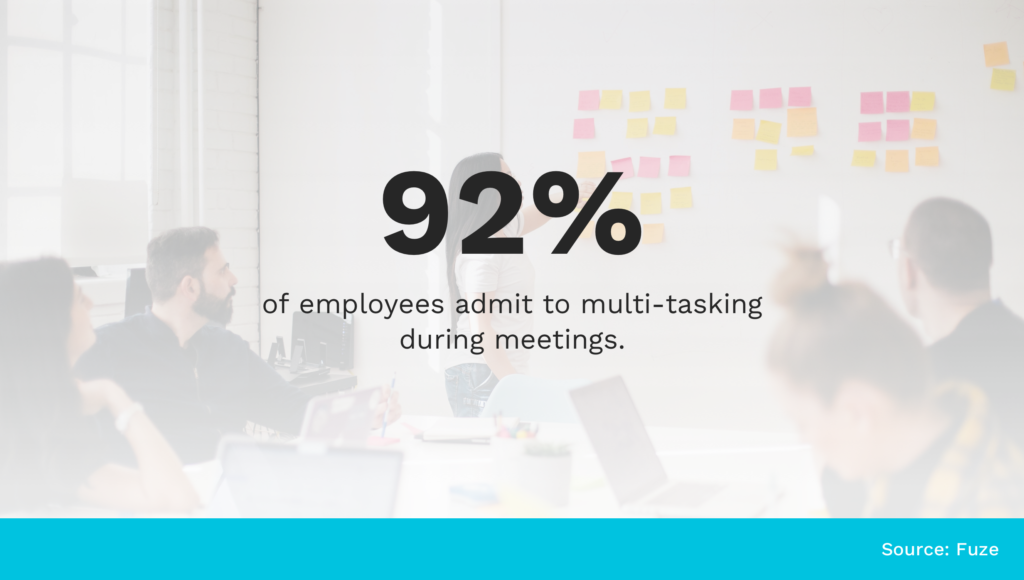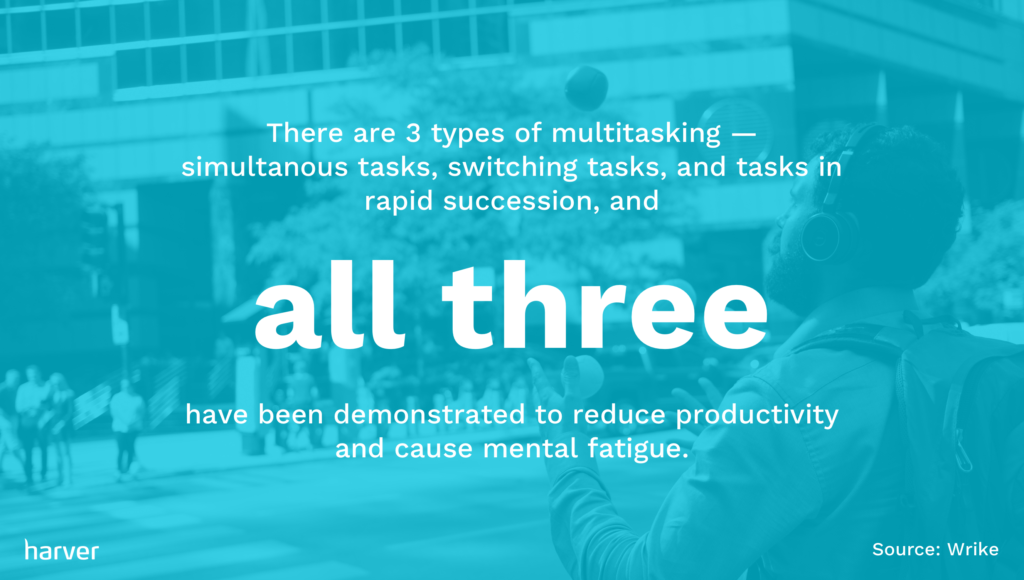Multitasking is a skill that’s often overlooked in recruitment, and sometimes for good reason. Multitaskers get a reputation for being easily distracted or lacking focus, and multitasking in general can be seen as a culprit for fatigue and loss of productivity. But the truth is, it can be a necessary evil the ability to multitask is important for a number of jobs.
No matter what your role, you’ve probably experienced getting pulled in multiple directions at one time or another. You’re working on a project while responding to emails or you’re pulled into a last minute meeting while trying to finalize a report. Having the ability to quickly switch gears or simultaneously work on tasks that must be done in tandem is crucial for keeping things moving forward.
From entry-level roles to management positions, employees need to be able to handle and prioritize a variety of projects or tasks at the same time—meaning it’s necessary to identify candidates capable of multitasking early in the recruitment process.
But what is multitasking and how can you test for it? Here are a few do’s and don’ts to keep in mind.
What’s in?
Like what you see?
Don’t miss out. Subscribe to our quarterly digest to get the latest TA and TM resources delivered right to your inbox.
What is multitasking?
Multitasking, or “task switching” is the ability to perform or manage more than one task at the same time. People with strong multitasking skills can take on multiple responsibilities at once and complete them all efficiently without compromising quality.
A great example of a multitasker is the receptionist in a busy office. The receptionist is able to manage and direct phone calls, welcome guests, and keep the day-to-day office operations running smoothly. That individual can switch between tasks quickly while still maintaining control of the items on pause. Of course, the receptionist would always be most productive with just one task to manage — but for many jobs, this is simply not the reality.
Multitasking doesn’t only apply to jobs you’d find in an office – but is also a critical skill for a variety of entry level roles, such as in a restaurant or a convenience store. For example, if you’re working in a quick service restaurant, you’ll need to be able to switch between tasks of equal priority – handling customers, completing orders, re-stocking, and keeping on top of cleaning — all while collaborating with a quickly moving team.
The need to multitask appears across all levels of an organization, from the new intern to the CEO. It’s not necessarily that multitasking itself is beneficial, rather typically the opposite, but that those with the ability to do it will be able to field necessary tasks with better outputs and less stress. Where necessary, strong multitasking abilities can help with:
- Moderating productivity. It’s no secret multitasking can harm productivity. But, when team members can easily switch between tasks, they are able to get more done at once. It’s rare any job allows employees to put their entire focus on a single task, so strong multitaskers can stay productive while juggling.
- More motivation. Everyone loves the feeling of checking things off their to do list. The feeling of accomplishment that comes with multitasking can keep team members feeling confident and motivated, while those who struggle to multi-task may be demotivated or become overwhelmed.
- Saves money. When a team member is more productive and motivated, they can save the company time and money. By spending less time on tasks, they’re able to take on more projects simultaneously and help things move forward efficiently.
There are some stereotypes about who makes a good multitasker. Some believe women are better multitaskers than men, or that younger generations have developed strong multitasking skills because of the amount of time they spend switching between apps on their phones, but these theories don’t hold up. When recruiting individuals for multitasking-heavy jobs, it’s not fair or effective to rely on stereotypes.

Multitasking can also get a bad reputation. Some people confuse multitasking with being distracted. When someone is juggling multiple things at once and barely hitting the mark on any of them, this isn’t multitasking—this is just taking on more than that individual can handle. A true multitasker can successfully handle multiple tasks without dropping the ball. These are the kinds of candidates recruiters should be looking for.
What roles require strong multitasking abilities?
There are a number of jobs that require multitasking skills. We’ve already gone over a couple. And while multitasking can be beneficial to just about every job, some require multitasking as a main skill. Here are some examples that show the range:
- Customer service representatives
- Bank tellers, receptionists & administrative assistants
- Restaurant & hospitality employees
- Healthcare workers (nurses, nursing assistants)
- Project managers, marketers & salespeople
Many of the responsibilities associated with these roles require talking to a variety of people, managing calendars, navigating multiple screens, searching and entering data, or moving quickly on your feet between tasks. The job responsibilities can also change quickly as critical situations arise, so people in these roles always need to be ready to shift their focus.
Multitasking roles also require individuals to know how to prioritize and schedule different projects. They need to be self-motivated to get things done when they have downtime and know how to come back to a project after something unexpected pops up. Depending on the role and specific position within the company, they may also need to delegate.
How to test for multitasking skills
If you’re recruiting for a job that requires multitasking to a great degree, you’ll want to test candidates’ skills before making a hiring decision. But how can you measure multitasking? Here are a few dos and don’ts.

Do: Define what kind of multitasking is necessary
It’s true that most tasks are done most effectively with 100% focus. However, in certain work environments, that option doesn’t exist.
While multitaskers can usually switch between a variety of tasks quickly, get specific about what you need candidates to be able to do in tandem. Laying out the specific responsibilities your candidates need to handle at once will give them a better idea of if the job is right for them—and lower your risk of hiring someone who can’t handle the job, or giving the impression that getting distracted is acceptable.
Do: Use a standardized multitasking test
When testing candidates on their multitasking skills, don’t jump to the hardest tasks to perform. If a task requires training, you may end up wasting time or scare off a candidate who would have been perfectly fit for your role. Instead, choose a scientifically validated test that requires no prior knowledge and can be easily administered during the application process.
Do: Consider combining your multitasking test with a job simulation
A realistic job preview or industry-specific test can give candidates a closer look at what the job actually entails and you can get a feel for whether or not they’re qualified for the role. For example, if you’re hiring for customer service roles, a simulation where candidates need to reply to multiple live chat support messages can help you better understand if they can cope with multiple responsibilities at once, in an environment that closely mimics the job they’ll be doing.
Do: Focus on tests measuring prospective memory
Prospective memory involves remembering to perform a task or action in the future. In other words, measuring if a candidate remembers to make a phone call later in the day. For a multitasking role, these kinds of tasks can come up often, so measuring a candidate’s ability to remember these kinds of tasks can be incredibly important to their ultimate success.
Do: Use gamified multitasking testing to make the candidate experience fun
When candidates are engaged with the tests they’re completing, you’re likely to see better results. Using a gamified multitasking test can keep your candidates’ attention and ensure you’re getting strong results. The more accurate your results are, the more likely you are to make the right hiring decision—and when candidates are excited about your organization, they’re more likely to accept a job if presented to them.
Do: Ask the right questions
Discussing multitasking during the interview process can give you a more comprehensive understanding of how a candidate deals with having many tasks on their plate. Ask about their unique process for handling multiple items at once and what tools they use to keep track of their work. Requesting an anecdote of a time they successfully multitasked in their career can add a new element of understanding to the recruiting process.
Don’t: Rely on interview answers alone
While interview questions can give you a deeper understanding of a candidate’s process, you shouldn’t make hiring decisions based solely on their responses. Completing some hands-on tests and tasks can help you see their process in action. When paired with their interview questions, hands-on performance can give you a strong indication of who is right for the job and who is not.
Don’t: Use resumes alone
Resumes are a great way to understand a candidate’s past experience, but relying on them alone rarely shows the whole picture. Someone may have worked in an environment that required multitasking, but that doesn’t always mean they performed well in it. On the other hand, a great multitasker may not have been given an opportunity to show off their skills. It’s important to give all candidates a fair opportunity and not assume too much about their ability based on their last job title, especially for entry level roles.

Don’t: Disregard the need for multitasking employees
Even if you don’t personally believe in the benefits of multitasking, don’t let this stand in your way of finding candidates capable of performing multiple jobs at once. Try to think about it a different way—are you looking for self-motivated employees who can pick up part of their job responsibility automatically? Do you want your employees to know how to prioritize and appropriately manage their time when things start to get busy? Do you want managers and leaders who know when to delegate tasks to get things done on time? All of these skills are part of multitasking.
Don’t: Look at multitasking as an isolated skill
We’ve talked a lot about multitasking, but you might call it something different. That’s okay because multitasking is actually deeply connected to other important skills like prioritizing, time management, communication skills, or in some cases, even computer aptitude. Don’t get too caught up on finding “multitasking” candidates. Instead, know how to make the right connections to find candidates who fit what you’re looking for.
Don’t: Confuse multitasking for procrastination
Although multitasking can get a bad rep, it is important to be able to tell the difference between multitasking and procrastination. If your candidate is just letting their tasks pile up because they’re easily distracted, they’re not multitasking, they’re procrastinating. Pay attention to who is actually capable of getting multiple things done at once and who is just avoiding completing a task before moving on to the next one.
Make multitasking a recruiting priority
Whether you’re hiring for a multitasking-heavy role or you just want to get the most efficient candidate in an open position as you can, prioritizing multitasking should be important to you during the recruitment process. While we’ve talked a lot about specific jobs that require individuals to switch tasks quickly and manage multiple things at once, almost every job will experience busy days where they’re being asked to do a dozen tasks simultaneously. If multitasking was a skill they were tested for during the recruitment and interviewing process, they’ll be equipped to handle those days.
Stop guessing,
Start data-driven hiring.
Learn how you implement a modern candidate selection process, that is: streamlined, experience-driven and backed by data.


